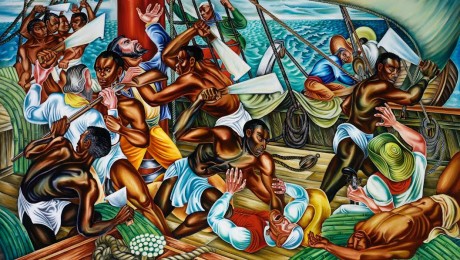
The Mutiny on the Amistad, 1939. Oil on canvas; 71 1/4 x 125 3/8. Collection of Talladega College, Talladaga, Ala.
The red mast is the only stationary object onboard. Before it, a tangle of human bodies heaves with action. The sun glints off contorted musculature, piles of sugar cane and raised cane knives as revolution rules the Amistad. The silken forms in Hale Woodruff’s most famous mural, “Mutiny on the Amistad,” surge into the foreground enveloping the viewer in the heightened moment.
The mural, measuring 20 feet wide, along with six other murals by Woodruff will be on display in the touring exhibition Rising Up: Hale Woodruff’s Murals at Talladega College at the Birmingham Museum of Art June 13 through September 6. The exhibit, organized by the High Museum of Art in collaboration with Talladega College, has been on the road since 2013 and consists of a massive collection of Woodruff’s work spanning from 1931 to 1979.
The installation is a rarity, the first of its kind in Birmingham and perhaps the last. Woodruff’s murals will return to their permanent home in the Savery Library at Talladega College after the last leg of the tour.
Established in 1867 to serve the educational advancement of newly freed slaves, Talladega College commissioned Woodruff to in 1938 conserve the story of the Amistad and highlights of the institution’s history. The opportunity to share the striking pieces arose when the murals were taken down for restoration.
“During my tenure at Talladega College, I have met many individuals who care deeply about these great works of art and are dedicated to their preservation,” said Billy C. Hawkins, president of Talladega College. “We are proud to make possible the conservation of these murals through this exhibition and it is a real pleasure to share our treasures.”
BMA curator Graham C. Boettcher echoed Hawkins’ high opinion of the murals and their significance.
“I was just up working on the installation and the colors and the technique and the texture is unreal,” Boettcher said. “It’s absolutely captivating.”
Boettcher explained that his deep admiration for Woodruff was forged when he was a student in New Haven, Conn. The New Haven Museum houses studies for Woodruff’s Amistad murals presented in an exhibit chronicling the story of the mutiny and the following trial held at a courthouse in New Haven.
For Boettcher, aside from Woodruff’s obvious artistic talent, what makes the murals national treasures is their legible translation of history.
“The other really key component of murals is not only that you be able to see the story from the distance, depending on how they’re installed, so the size matters, but also narrative clarity matters,” Boettcher said. “You have to be able to understand the story very quickly because you’re counting on people seeing these who may or may not have an intimate familiarity with the story.”
Murals’ didactic potential makes them one of the most difficult and most valuable channels for charting the scope of history. The effect is immediate. The monumental scale of the art demands attention. At a glance, the viewer who encounters a mural should be able to empathize with the subjects, gauge their feelings and the momentum of the story.
An apprentice of Mexican muralist Diego Rivera, Woodruff expertly electrifies the events of American history that marked significant moments in the advancement of African Americans, but as Boettcher pointed out, historic art isn’t simply to recount the activities of our ancestors.
“A work of art doesn’t just go up on the wall, and then it’s fixed in time and means the same thing as it always did,” he said. “A work of art takes on new meaning over and over again, and that’s how it becomes an icon.”
When Rising Up began its tour two years ago the nation was still sheltered from the impact of the shooting of Michael Brown in Ferguson, the breaking news of police brutality throughout the country and the very real threat of a new wave of racism. The exhibit’s arrival in Birmingham at the heels of this national civil unrest and the 50th anniversary of the passage of the Voting Rights Act was pure coincidence, according to Boettcher. However, the themes of the Amistad murals and the legacy of Talladega College are iconic: relevant over and over again, transcending time, race and the art itself.





